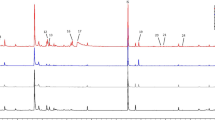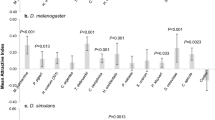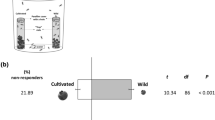Abstract
The olfactory cues used by various animals to detect and identify food items often include volatile organic compounds (VOCs) produced by food-associated microorganisms. Microbial VOCs have potential as lures to trap animal pests, including insect crop pests. This study investigated microorganisms whose VOCs are attractive to natural populations of the spotted wing drosophila (SWD), an invasive insect pest of ripening fruits. The microorganisms readily cultured from wild SWD and SWD-infested fruits included yeasts, especially Hanseniaspora species, and various bacteria, including Proteobacteria (especially Acetobacteraceae and Enterobacteriaceae) and Actinobacteria. Traps in a raspberry planting that were baited with cultures of Hanseniaspora uvarum, H. opuntiae and the commercial lure Scentry trapped relatively high numbers of both SWD and non-target drosophilids. The VOCs associated with these baits were dominated by ethyl acetate and, for yeasts, other esters. By contrast, Gluconobacter species (Acetobacteraceae), whose VOCs were dominated by acetic acid and acetoin and lacked detectable ethyl acetate, trapped 60–75% fewer SWD but with very high selectivity for SWD. VOCs of two other taxa tested, the yeast Pichia sp. and Curtobacterium sp. (Actinobacteria), trapped very few SWD or other insects. Our demonstration of among-microbial variation in VOCs and their attractiveness to SWD and non-pest insects under field conditions provides the basis for improved design of lures for SWD management. Further research is required to establish how different microbial VOC profiles may function as reliable cues of habitat suitability for fly feeding and oviposition, and how this variation maps onto among-insect species differences in habitat preference.



Similar content being viewed by others
References
Adler LS (2000) The ecological significance of toxic nectar. Oikos 91:409–420
Arguello JR, Sellanes C, Lou YR, Raguso RA (2013) Can yeast (S. cerevisiae) metabolic volatiles provide polymorphic signaling? PLoS One 8:e70219
Asplen MK, Anfora G, Biondi A, Choi DS, Chu D, Daane KM, Gibert P, Gutierrez AP, Hoelmer KA, Hutchison WD et al (2015) Invasion biology of spotted wing drosophila (Drosophila suzukii): a global perspective and future priorities. Pest Manag Sci 88:469–494
Atallah J, Teixeira L, Salazar R, Zaragoza G, Kopp A (2014) The making of a pest: the evolution of a fruit-penetrating ovipositor in Drosophila suzukii and related species. Proc Biol Sci 281:20132840
Basoalto E, Hilton R, Knight A (2013) Factors affecting the efficacy of a vinegar grap for Drosophila suzukii. J Appl Entomol 137:561–570
Becher PG, Flick G, Rozpedowska E, Schmidt A, Hagman A, Lebreton S, Larsson MC, Hansson BS, Piskur J, Witzgall P, Bengtsson M (2012) Yeast, not fruit volatiles mediate Drosophila melanogaster attraction, oviposition and development. Funct Ecol 26:822–828
Beck JJ, Vannette RL (2017) Harnessing insect-microbe chemical communications to control insect pests of agricultural systems. J Agric Food Chem 65:23–28
Benjamini Y, Hochberg Y (1995) Controlling the false discovery rate: a practical and powerful approach to multiple testing. J Roy Statist Soc B 57:289–300
Bing X, Gerlach J, Loeb G, Buchon N (2018) Nutrient-dependent impact of microbes on Drosophila suzukii development. mBio 9:02199–02117
Bost A, Franzenburg S, Adair KL, Martinson VG, Loeb G, Douglas AE (2018) How gut transcriptional function of Drosophila melanogaster varies with the presence and composition of the gut microbiota. Mol Ecol 27:1848–1859
Cha DH, Adams T, Rogg H, Landolt PJ (2012) Identification and field evaluation of fermentation volatiles from wine and vinegar that mediate attraction of spotted wing Drosophila, Drosophila suzukii. J Chem Ecol 38:1419–1431
Cha DH, Adams T, Werle CT, Sampson BJ, Adamczyk JJ, Rogg H, Landolt PJ (2014) A four-component synthetic attractant for Drosophila suzukii (Diptera: Drosophilidae) isolated from fermented bait headspace. Pest Manag Sci 70:324–331
Cha DH, Loeb GM, Linn CE, Hesler SP, Landolt PJ (2018) A multiple-choice bioassay approach for rapid screening of key attractant volatiles. Environ Entomol 47:946–960
Clarke KR, Gorley RN (2006) PRIMER v6: user manual/tutorial. In: PRIMER-e. https://www.primer-e.com/
Cloonan KR, Abraham J, Angeli S, Syed A, Rodriguez-Saona C (2018) Advances in the chemical ecology of the spotted wing Drosophila (Drosophila suzukii) and its applications. J Chem Ecol 44:922–939
Cribari-Neto F, Zeileis A (2010) Beta Regression in R. J of Stat Softw 34(2):1–24 http://www.jstatsoft.org/v34/i02/
Davis TS, Crippen TL, Hofstetter RW, Tomberlin JK (2013) Microbial volatile emissions as insect semiochemicals. J Chem Ecol 39:840–859
Dominy NJ (2004) Fruits, fingers, and fermentation: the sensory cues available to foraging primates. Integr Comp Biol 44:295–303
Douglas AE (2018) What will it take to understand the ecology of symbiotic microorganisms. Env Microbiol 20:1920–1924
Dudley R (2000) Evolutionary origins of human alcoholism in primate frugivory. Q Rev Biol 75:3–15
Feng Y, Bruton R, Park A, Zhang A (2018) Identification of attractive blend for spotted wing Drosophila, Drosophila suzukii, from apple juice. J Pest Sci 91:1251–1267
Fukatsu T, Nikoh N (1998) Two intracellular symbiotic bacteria from the mulberry psyllid Anomoneura mori (Insecta, Homoptera). Appl Environ Microbiol 64:3599–3606
Hamby KA, Hernandez A, Boundy-Mills K, Zalom FG (2012) Associations of yeasts with spotted-wing Drosophila (Drosophila suzukii; Diptera: Drosophilidae) in cherries and raspberries. Appl Environ Microbiol 78:4869–4873
Iglesias LE, Nyoike TW, Liburd OE (2014) Effect of trap design, bait type, and age on captures of Drosophila suzukii (Diptera: Drosophilidae) in berry crops. J Econ Entomol 107:1508–1518
Janzen DH (1977) Why fruits rot, seed mold, and meat spoils. Am Nat 111:691–713
Keesey IW, Knaden M, Hansson BS (2015) Olfactory specialization in Drosophila suzukii supports an ecological shift in host preference from rotten to fresh fruit. J Chem Ecol 41:121–128
Keesey IW, Grabe V, Gruber L, Koerte S, Obiero GF, Bolton G, Khallaf MA, Kunert G, Lavista-Llanos S, Valenzano DR et al (2019) Inverse resource allocation between vision and olfaction across the genus Drosophila. Nat Commun 10:1162
Kirkpatrick DM, McGhee PS, Hermann SL, Gut LJ, Miller JR (2016) Alightment of spotted wing Drosophila (Diptera: Drosophilidae) on odorless disks varying in color. Environ Entomol 45:185–191
Kleiber JR, Unelius CR, Lee JC, Suckling DM, Qian MC, Bruck DJ (2014) Attractiveness of fermentation and related products to spotted wing Drosophila (Diptera: drosophilidae). Environ Entomol 43:439–447
Knight AL, Basoalto E, Yee W, Hilton R, Kurtzman CP (2015) Adding yeasts with sugar to increase the number of effective insecticide classes to manage Drosophila suzukii (Matsumura) (Diptera: Drosophilidae) in cherry. Pest Manag Sci 72:1482–1490
Liscia A, Angioni P, Sacchetti P, Poddighe S, Granchietti A, Setzu MD, Belcari A (2013) Characterization of olfactory sensilla of the olive fly: behavioral and electrophysiological responses to volatile organic compounds from the host plant and bacterial filtrate. J Insect Physiol 59:705–716
Little CM, Chapman TW, Hillier NK (2018) Effect of color and contrast on highbush blueberries to host-finding behavior by Drosophila suzukii (Diptera: Drosophilidae). Environ Entomol 47:1242–1251
MacCollum GB, Lauzon CR, Weires RW, Rutowski AA (1992) Attraction of adult apple maggot (Diptera: Tephritidae) to microbial isolates. J Econ Entomol 85:83–87
Mazzetto F, Gonella E, Crotti E, Vacchini V, Syrpas M, Pontini M, Mangelinckx S, Daffonchio D, Alma A (2016) Olfactory attraction of Drosophila suzukii by symbiotic acetic acid bacteria. J Chem Ecol 89:783–792
Mori BA, Whitener AB, Leinweber Y, Revadi S, Beers EH, Witzgall P, Becher PG (2017) Enhanced yeast feeding following mating facilitates control of the invasive fruit pest Drosophila suzukii. J Appl Ecol 54:170–177
Oksanen J, Blanchet FG, Friendly M, Kindt R, Legendre P, McGlinn D, Minchin PR, O’Hara RB, Simpson GL, Solymos P, et al. (2019) Vegan: community ecology package. (R package version 2.5-4). https://CRAN.R-project.org/package=vegan
R Core Team (2015) R: a language and environment for statistical computing. R Foundation for Statistical Computing, Vienna, Austria
Rice KB, Short BD, Jones SK, Leskey TC (2016) Behavioral responses of Drosophila suzukii (Diptera: Drosophilidae) to visual stimuli under laboratory, semifield, andfField conditions. Environ Entomol 45:1480–1488
Rice KB, Short BD, Leskey TC (2017) Development of an attract-and-kill strategy for Drosophila suzukii (Diptera: Drosophilidae): evaluation of attracticidal spheres under laboratory and field conditions. J Econ Entomol 110:535–542
Robacker DC, Lauzon CR, He X (2004) Volatiles production and attractiveness to the Mexican fruit fly of Enterobacter agglomerans isolated from apple maggot and Mexican fruit flies. J Chem Ecol 30:1329–1347
Ruxton GD, Wilkinson DM, Schaefer HM, Sherratt TN (2014) Why fruit rots: theoretical support for Janzen's theory of microbe-macrobe competition. Proc Biol Sci 281:20133320
Scheidler NH, Liu C, Hamby KA, Zalom FG, Syed Z (2015) Volatile codes: correlation of olfactory signals and reception in Drosophila-yeast chemical communication. Sci Rep 5:14059
Schetelig MF, Lee K-Z, Otto S, Talmann L, Stokl J, Degenkolb T, Vilcinskas A, Halitschke R (2017) Environmentally sustainable pest control options for Drosophila suzukii. J Appl Entomol 142:3–17
Stensmyr MC, Dweck HK, Farhan A, Ibba I, Strutz A, Mukunda L, Linz J, Grabe V, Steck K, Lavista-Llanos S, Wicher D, Sachse S, Knaden M, Becher PG, Seki Y, Hansson BS (2012) A conserved dedicated olfactory circuit for detecting harmful microbes in Drosophila. Cell 151:1345–1357
Swoboda-Bhattarai KA, McPhie DR, Burrack HJ (2017) Reproductive status of Drosophila suzukii (Diptera: Drosophilidae) females influences attraction to fermentation-based baits and ripe fruits. J Econ Entomol 110:1648–1652
Tasin M, Knudsen GK, Pertot I (2012) Smelling a diseased host: grapevine moth responses to healthy and fungus-infected grapes. Anim Behav 83:552–562
Verheggen F, Perrault KA, Megido RC, Dubois LM, Fancis F, Haubruge E, Forbes SL, Focant J-F, Stefanuto P-H (2017) The odor of death: an overview of current knowledge on characterization and applications. BioScience 67:600–613
Werner T, Steenwinkel T, Jaenike J (2018) Drosophilids of the Midwest and northeast. Open Access Books, Michigan Tech University, MI
White TJ, Bruns T, Lee S, Taylor J (1990) Amplification and direct sequencing of fungal ribosomal RNA genes for phylogenetics. In: Innis MA, Gelfand DH, Sninsky JJ, White TJ (eds) PCR protocols: a guide to methods and applications. Academic Press, New York, pp 315–322
Wiens F, Zitzmann A, Lachance MA, Yegles M, Pragst F, Wurst FM, von Holst D, Guan SL, Spanagel R (2008) Chronic intake of fermented floral nectar by wild treeshrews. Proc Natl Acad Sci U S A 105:10426–10431
Acknowledgements
We thank Alyssa Bost for help with gut dissections, Gabrielle Brind Amour who assisted with field assessment, Francoise Vermeylen and Dong Ho Cha for statistical advice, Wendy Kozlowski for data archiving at eCommons, and Dara Stockton who prepared Fig. 1. This research was funded by NIFA grant NYC-191404.
Author information
Authors and Affiliations
Contributions
The study was designed by AED, GML and RAR. The microbiology was conducted EB and JGM, the field experiments by SH and GML, and the VOC analysis by KRM and RAR. All authors contributed to writing the manuscript.
Corresponding author
Rights and permissions
About this article
Cite this article
Bueno, E., Martin, K.R., Raguso, R.A. et al. Response of Wild Spotted Wing Drosophila (Drosophila suzukii) to Microbial Volatiles. J Chem Ecol 46, 688–698 (2020). https://doi.org/10.1007/s10886-019-01139-4
Received:
Revised:
Accepted:
Published:
Issue Date:
DOI: https://doi.org/10.1007/s10886-019-01139-4




